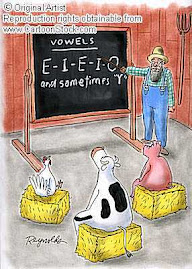Personalize funny videos and birthday eCards at JibJab!
Friday, October 31, 2014
MY TIME IN JAIL ...
It's Halloween time of the year once again!
Here is a text that Hélène Parent, ESL student, advanced group
composed and shared with us in class this past week.
The 'horrors' of what was once time spent in jail...
I WANT TO SHARE WITH YOU MY TIME IN JAIL …
Don't be afraid I'm not a criminal. I just had the opportunity to visit the old
jail in Trois-Rivières. It's possible to
sleep there for a night and eat the prisoner's breakfast but after my visit I wouldn’t
stay there anymore. The stone walls are
very thick so it's always cold and humid.
Furthermore the prisoners' conditions were horrible. Anyone
could be incarcerated, they could have been as young as 10 or 12 years old and also for a minor offence.
This
detention centre opened officially in 1822 and remained in operation until
1986. Most of the time it was
overcrowded. There was no privacy so you
can imagine all the problems, bad odors, noise, fights. When a prisoner came in the guard gave him or
her the prisoner's gift: a pair of pants, a shirt, a pillow (a used one full of
all you can imagine) and a rough grey woolen blanket; then brought to the cell.
To welcome him, the oldest prisoner of the cell required the newcomer to exchange his effects against his.
There
were six beds in the men’s cell but most of the time up to eighteen prisoners
lived there. So most of them slept on
the floor, close to the toilet buckets (one bucket for six prisoners). The most recent arrival was in charge of
emptying that bucket. Every day the
prisoners ate the same meal which consisted of oats, beans and bread. They were allowed to wash themselves once a week but there was only one bar of soap for all
the prisoners in the cell. Too bad for the last ones! They could go outside one hour a week but
only weather permitting. They spent the
whole day standing up in a small room in front of the cell. They had nothing to do except smoke and fight. They couldn't complain about their condition
otherwise they were beaten by the guards and locked up nude in a dark frozen
dungeon, full of spiders and rats. Rarely
did they have visitors. Under the
supervision of a jailer, three prisoners could sit behind a grid in front of
three visitors. No intimacy, no
complaining allowed.
The women's detention conditions were a bit different but
also very harsh. Each one lived in a
tiny cell surrounded by grids large enough for a bed and a toilet bucket. They were allowed to keep with them one of
their children. In the beginning, people could witness the hangings. At the end the administration built a stone wall all around the prison so it was impossible to see the "show". But many people who lived nearby charged a fee and let the others climb on their roofs.
This visit was such an experience. The guide was very
interesting and made us feel like a prisoner.
Each visitor in turn had to play a role. As the visit was ending, I told
him that if he were to teach the same way in class, he would be a great
teacher. He answered me by saying that I
had better not try to corrupt him.
THANKS HÉLÈNE for sharing
part of our lurid and
gruesome past with us.
Thanks for writing and informing us.
SUZANNE
EXTRA INFORMATION
Following the posting of this text I got an email which actually is a comment from a former student, Huguette. THANKS!!!
What she wrote about is an annual celebration at the jail which gives another meaning to experiencing FEARS. Every year during the Halloween period they organize a theme relating to this Holiday. This year it was about transforming the jail into a makeshift hospital. They invite you to challenge your greatest fears. Do you dare try it?
The following is from the site. It is the
2014 edition.
Alert: A strange parasite attacks the people of Trois-Rivières! Day after day, the people around you are getting sick: some fall into a deep coma, others succumb to hemorrhagic fever or become severely deformed while several completely lose reason. Are you infected? As a preventive measure, you are taken to the Old Prison of Trois-Rivières, temporarily transformed into a makeshift hospital. How do you resist the mysterious parasite in this prison life worrying?
Alert: A strange parasite attacks the people of Trois-Rivières! Day after day, the people around you are getting sick: some fall into a deep coma, others succumb to hemorrhagic fever or become severely deformed while several completely lose reason. Are you infected? As a preventive measure, you are taken to the Old Prison of Trois-Rivières, temporarily transformed into a makeshift hospital. How do you resist the mysterious parasite in this prison life worrying?
Monday, October 27, 2014
WHO put the EEN in Hallow'een.???
The Meaning
of “Een” in Halloween
Today Halloween is primarily marked by putting on a
disguise and asking for candy, but Halloween has its roots in at least two
Medieval celebrations: the Celtic festival of
Samhain and the Christian holiday All Saint’s Day.
The spooky festival’s name, however, comes from only one.
Samhain is Gaelic
for “summer’s end,” and marks what has loosely been labeled the
“Celtic New Year,” the end of the “lighter half” of the year and the beginning
of the “darker half.” One of the four fire festivals of the year, it was
celebrated on November 1 when, it was believed, the dead arose for one night. Sound
familiar?The other celebration, All Saint’s Day, honors all of the Catholic saints. The Roman Catholic Church refers to it as the “Solemnity of All Saints.” Though this celebration does not bear a close resemblance to the festivities of Halloween, it did give the holiday its name. The word Halloween is a direct derivation of All Saints’ Day. All Hallows in Old English means “the feast of the saints.”
Halloween, first attested in the 18th century, is a Scottish variant of All-Hallows-Even. The Even meant EVEning. The spelling of the word was once Hallowe’en, in which the “v” was elided. The current spelling wasn’t widely adopted until the 20th century.
SEE you in the classroom
SUZANNE
Thursday, October 16, 2014
THE HISTORY OF STANDARD TIME
Last night I just stumbled
upon a very interesting documentary on TIME on the PBS channel. This morning I went
to Wikipedia and found the following. I thought it might interest you!
Read what follows and then answer the question.The history of standard time in the United States began November 18, 1883 when United States and Canadian railroads instituted standard time in time zones. Before then, time of day was a local matter, and most cities and towns used some form of local solar time, maintained by some well-known clock
(for example, on a church steeple or in a jeweler's window).
The new standard time system was not immediately embraced by all. Use of standard time gradually increased because of its obvious practical advantages for communication and travel.
Daylight time became a local matter. It was re-established nationally early in World War II, and was continuously observed until the end of the war. Time zone boundaries have changed greatly since their original introduction and changes still occasionally occur.
The standardizing of TIME was adopted all around the world for a very practical reason. THESE DAYS… think about AIR TRAVEL. All around the world, air traffic controllers use the SAME TIME!!! A good thing when you think of our safety!!
QUESTION:
What are some of the different tools we use
to visualize time???
Some interesting TRIVIA!!!
SUZANNE
Monday, October 13, 2014
INTERESTING LINKS to English pronunciation
Here are some
LINKS to another variety of ESL videos.
These are especially for English
pronunciation.
concerning ALL the aspects of English pronunciation
such as:
rhythm, accent, intonation,… etc.
2) a CLICK/REPEAT of all
the English sounds that you will find on the IPA chart: http://www.stuff.co.uk/calcul_nd.htm
3)
Short video explaining the schaw sound:
Hope that these were HELPFUL for you.
How about some feedback!!
Have fun!
SUZANNE
READING for VOCABULARY
READING and VOCABULARY
Here are some very helpful
tips from your teacher
#3 Use a dictionary or use a BROWSER > a computer program that is used to find and look at information on the nternet http://en.wiktionary.org/wiki/Wiktionary:Main_Page
Ù If you are reading online, you may be able to right-clcik on a word to look it up.
#4 Sign
up for a 'word a day' email. http://www.merriam-webster.com/
#5 Think of ways of remembering words. Do they
sound like a word in French?
with other words. Try to learn these 'collocations'.
Subscribe to:
Comments (Atom)

















.jpg)